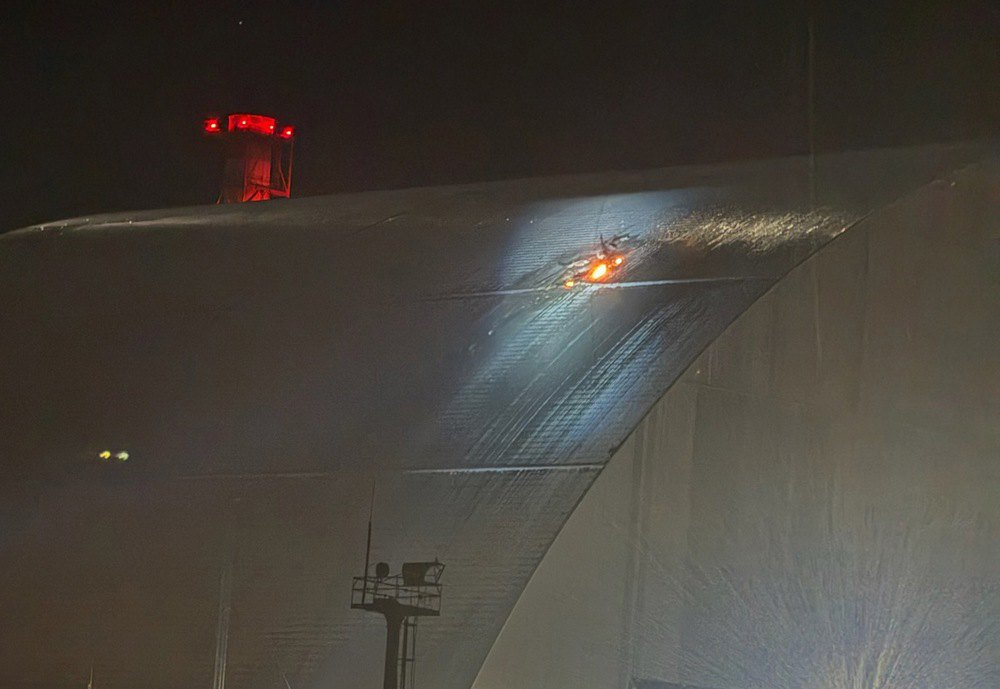
Russian nuclear terrorism
At dawn on Friday, 14 February, a Russian drone carrying an explosive warhead rammed into the sarcophagus over Reactor 4 at the Chornobyl NPP. The impact pierced the shelter, creating a hole much larger than a human being.
“The strike on the protective structure of Reactor 4 at the Chornobyl nuclear power plant poses a real threat of radiation contamination, the consequences of which are unpredictable,” said Svitlana Hrynchuk, Ukraine’s Minister of Environmental Protection and Natural Resources.
The sarcophagus over the destroyed reactor was completed in 2016. The project, funded by a coalition of around 45 countries, cost more than $1.5 billion.
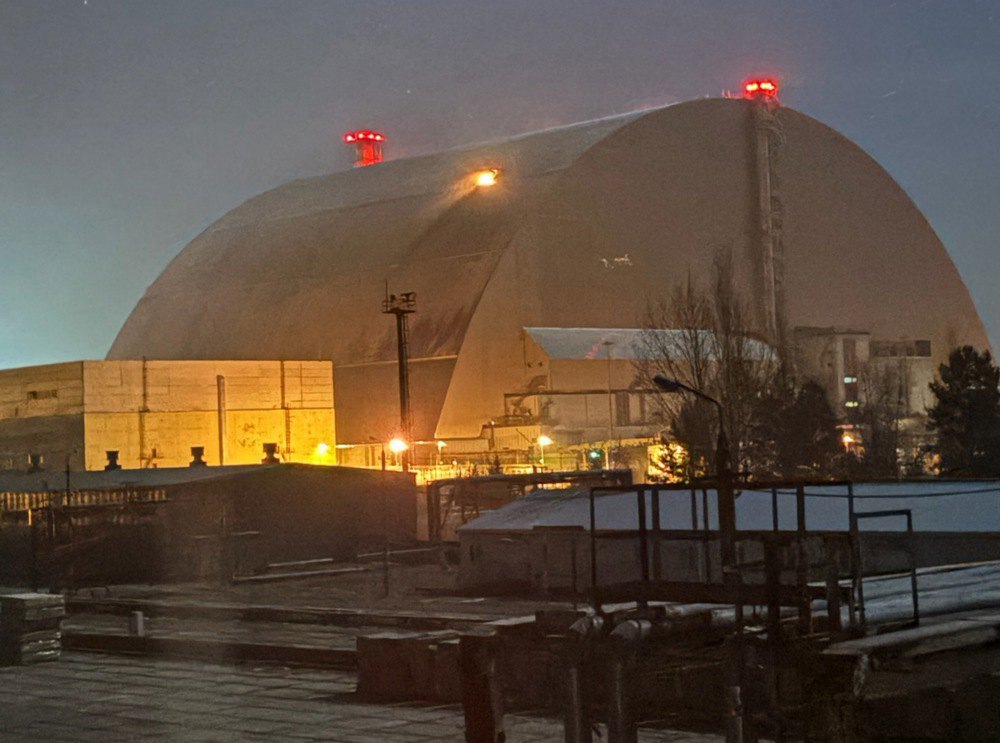
Following the strike, the outer lining of the ChNPP sarcophagus continued to smoulder for more than a day. A large-scale fire was prevented thanks to the swift response of rescuers, who managed to localise the fire immediately.
“The personnel are rotated constantly. We are ensuring that no one is exposed to radiation,” said Andriy Danyk, head of the State Emergency Service.
The insulation beneath the sarcophagus’s metal framework was smouldering. Firefighters had to extinguish it under extremely difficult conditions - the building is over 100 metres high (about the height of a 35-storey building). Adverse weather, including strong winds, snow, and frost, further complicated the operation.
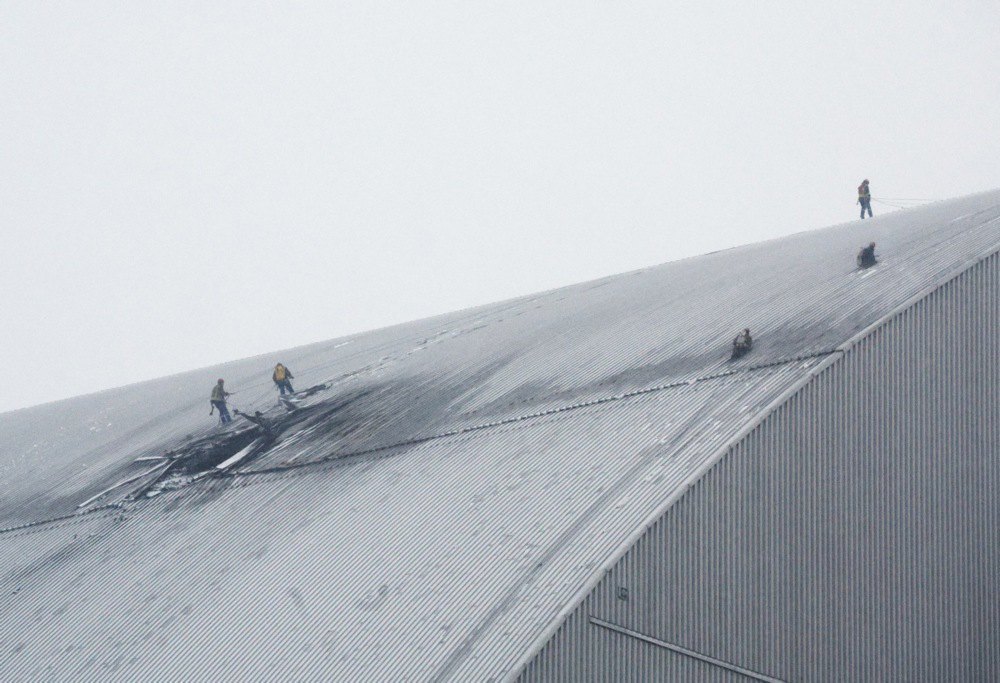
The sarcophagus sustained significant damage: up to 15 square metres of the roof of the protective structure were destroyed, and around 200 square metres were deformed. The State Agency of Ukraine on Exclusion Zone Management has not yet announced the cost of repairs or when reconstruction might begin.
“This is not Russia’s first crime in the Exclusion Zone. At the beginning of the full-scale invasion, Russian forces seized the Chornobyl NPP. For over a month, they held the plant’s personnel hostage, violating every possible nuclear safety regulation and creating the risk of another Chornobyl disaster. They also looted scientific and research facilities, stealing equipment used to monitor radiation levels,” Hrynchuk recalled.
The Security Service of Ukraine (SBU) confirmed that the sarcophagus was struck by a Russian Shahed kamikaze drone. The drone’s wreckage has been collected as evidence. According to the SBU, the attack was deliberate, with Russian forces intentionally targeting the nuclear facility.
“The Chornobyl shelter is essential to containing the vast radioactive materials inside Reactor 4. This attack must serve as a final wake-up call for the international community to urgently provide more aid to Ukraine to protect its critical infrastructure,” Greenpeace Ukraine stated.
What are the consequences of the attack on the Chornobyl NPP?
Since Friday, the State Emergency Service has been dismantling the damaged section of the Chornobyl nuclear power plant’s sarcophagus. The government has assured that radiation levels at the site remain within normal limits.
Measurements are taken using an automated monitoring system that operates 24/7. The results are sent to a control centre every hour and, in emergencies, every minute. The system analyses 39 indicators, and this data is published by the State Agency of Ukraine on Exclusion Zone Management.
Radiation levels in the Exclusion Zone are also monitored by independent experts, who have confirmed that the situation remains under control.
“Saveecobot is the largest aggregator of information on radiation levels in Ukraine. In the Chornobyl Exclusion Zone, we monitor several data sources, including those provided by international partners and those installed by us. The radiation levels in and around the exclusion zone remain within standard limits,” said Iryna Chernysh, co-founder of SaveDnipro.
Ukraine has informed international organisations about the Russian attack on the Chornobyl nuclear power plant. In particular, the information was shared with the IAEA and the European Civil Protection Office. Despite the current stability at the plant, the risk of radiation leakage remains.
“The shelter has ceased to fulfil its function. There is now a possibility of radioactive substances being released due to certain events that may occur at the old facility,” warned Oleksandr Tytarchuk, Chief Engineer of the Chornobyl NPP.
According to IAEA experts, there are no signs of a breach in the Chornobyl reactor vessel. They recorded explosions at the plant but did not specify their cause. The IAEA also confirmed that radiation levels around the plant remain normal.
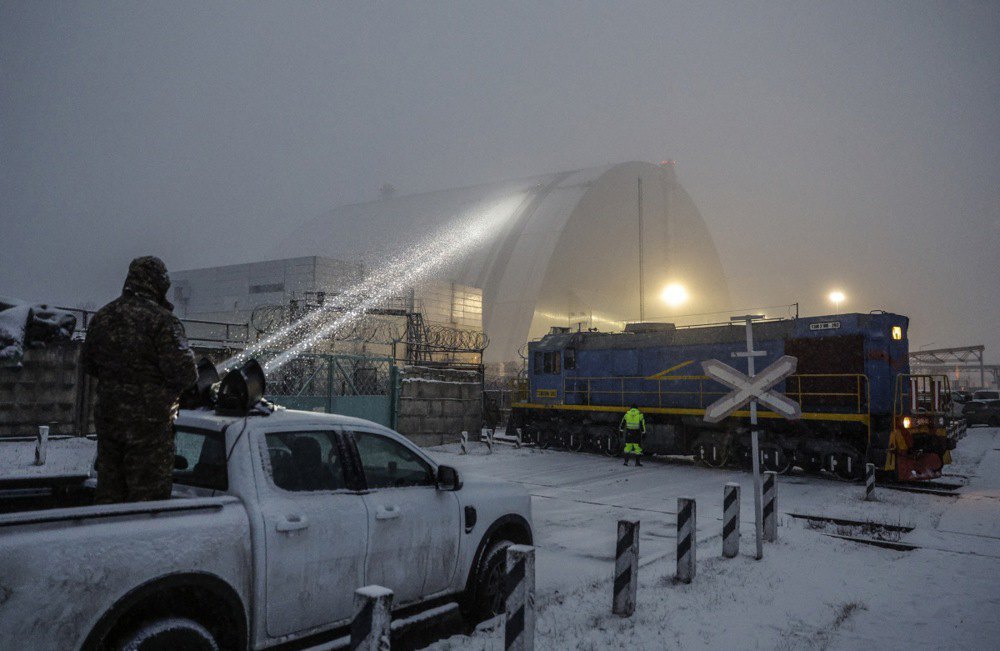
The consequences of the Russian attack could have been far worse if the drone had struck just a few metres closer to the old shelter of the reactor unit built after the 1986 Chornobyl disaster. In that case, the Kremlin would have provoked a new radiation accident, the State Agency of Ukraine on Exclusion Zone Management reported.
“Inside the shelter, there is equipment - a so-called ‘garage’ for maintaining the system and main cranes. The drone hit the outer cover, pierced it, fell into this system, and exploded there. Had it been 15-20 metres in another direction, it would have hit the old shelter, which is 40 years old,” explained Oleksandr Tytarchuk.
Chornobyl NPP experts have already inspected the sarcophagus’ supporting structures. The hole caused by the Russian drone strike will not lead to the roof collapsing. However, only certified specialists are authorised to carry out any repairs. They must inspect the facility, provide official conclusions, and only then can work on designing and patching the hole begin.
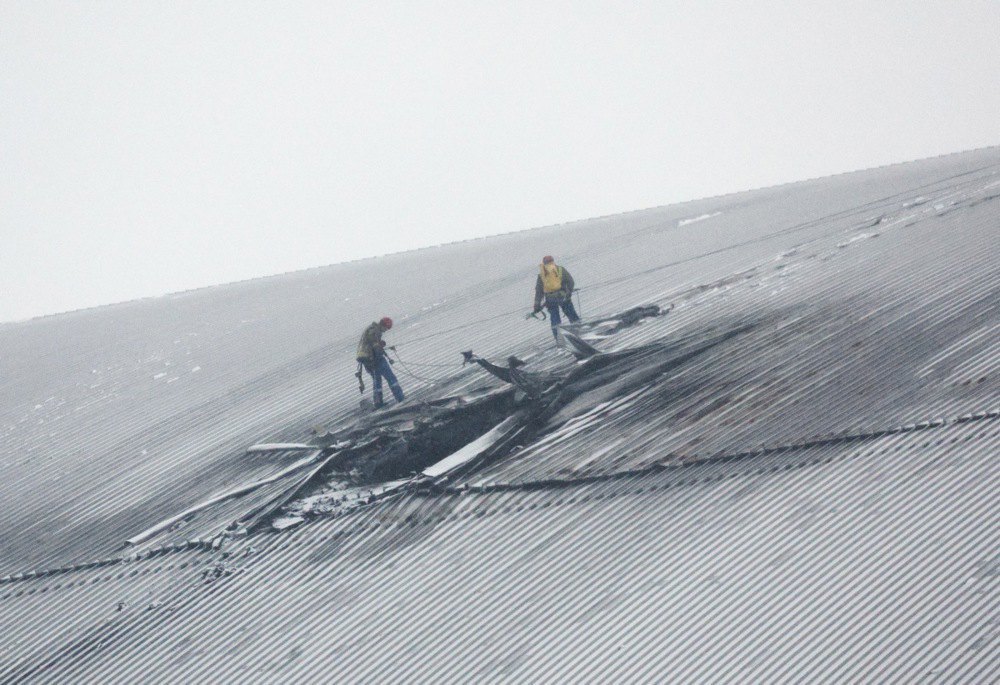
According to nuclear safety expert Olha Kosharna, about 200 tonnes of nuclear fuel remain inside the Chornobyl reactor destroyed in 1986. Under extreme heat, this fuel turned into lava.
“This is the most highly radioactive waste. Since 1986, this lava has gradually transformed into hazardous radioactive dust due to time, seasonal temperature fluctuations, and precipitation seeping in through leaks in the old shelter. Dust suppression is periodically carried out according to regulations. However, due to high radiation levels, removing these fuel-containing materials remains impossible,” explained Olha Kosharna.
Unpunished evil returns
At the Chornobyl nuclear power plant, Russia has once again committed a crime unprecedented in world history. No one has ever attempted to destroy a nuclear facility as dangerous as this one.
Yet, this is not a new tactic for the Kremlin. In 2014, Russia occupied Crimea, where the Sevastopol University of Nuclear Energy and Industry housed a research reactor, IR-100. Its current condition remains unknown.
In March 2022, the world was stunned when Russian forces seized the Zaporizhzhya NPP. The Kremlin even ordered attacks on the plant, leading to a fire in the ZNPP training centre.
“For the first time in the history of nuclear power, my staff had to carry out complex technical switches under direct fire to maintain the plant’s nuclear safety and ensure continued power generation,” said Oleh Dudar, then head of ZNPP’s operational unit.
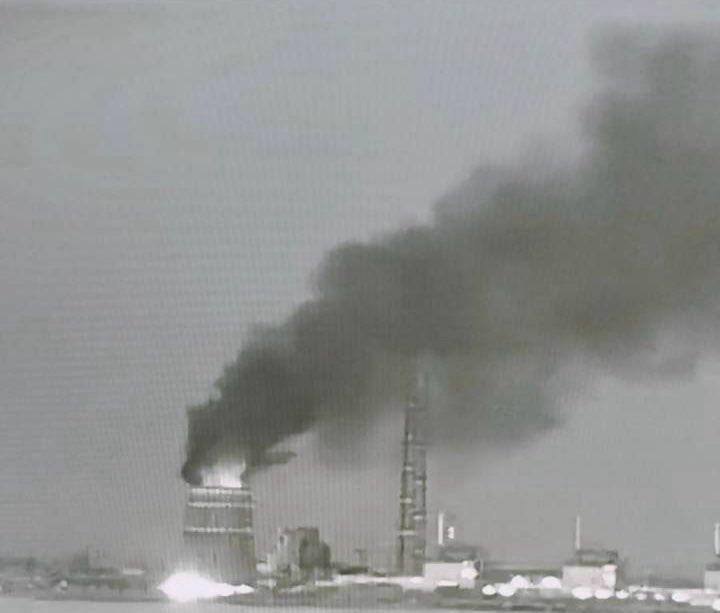
In March and June 2022, Russian artillery strikes hit the Kharkiv Institute of Technology, which houses the Neutron Source research nuclear facility. According to IAEA experts who visited Kharkiv, the equipment suffered severe damage. It was a miracle that no radiation was released.
Then, in April 2024, Russian shelling left the Neutron Source in Kharkiv without power. A catastrophe was narrowly avoided thanks to the coordinated efforts of scientists who had prepared for such an event. They swiftly switched the facility to diesel generators.
Despite these grave and reckless actions, the Kremlin has faced little accountability. No sanctions have been imposed on Rosatom, allowing it to legally continue participating in nuclear facility construction worldwide. Moreover, Russia remains a full member of the IAEA. In fact, Russian official Mikhail Chudakov still holds the positions of deputy head of the organisation and head of its nuclear energy department.
“The drone strike on the shelter over Chornobyl’s fourth unit proves that the Kremlin has no red lines. This is Putin’s ‘dignified’ response to Trump’s remarks about Russia’s supposed readiness for peace and the need to cede Ukrainian territories. This is what happens when you engage with the KGB,” said Volodymyr Omelchenko, director of energy programmes at the Razumkov Centre.
Russia attacked the Chornobyl nuclear power plant on the first day of the Munich Security Conference - a highly symbolic event for the Kremlin. On 10 February 2007, at the Munich Conference, Vladimir Putin first publicly attacked the post-war world order. That speech was followed by Russia’s invasion of Georgia in 2008, the annexation of Crimea and the occupation of parts of eastern Ukraine in 2014, and eventually the full-scale invasion.
“During the Munich conference, Putin wants to show that he can do anything. This is an act of nuclear terrorism. I sincerely hope that the international tribunal, which is being established to investigate Russia’s war crimes, will finally start working in April. The tribunal’s charter has already been agreed upon, and the Chornobyl case must be addressed,” said Olha Kosharna.
Although the Munich Security Conference was overshadowed by an anti-European speech from the US Vice President, Ukraine successfully conveyed to its international partners the severity of Russia’s drone strike on the Chornobyl nuclear power plant.
Volodymyr Zelenskyy revealed that Russia programmed the drone’s flight path to follow an ultra-low altitude, making it undetectable by radar. The President of Ukraine added that with such strikes, the Kremlin is proving that it has no interest in peace.








